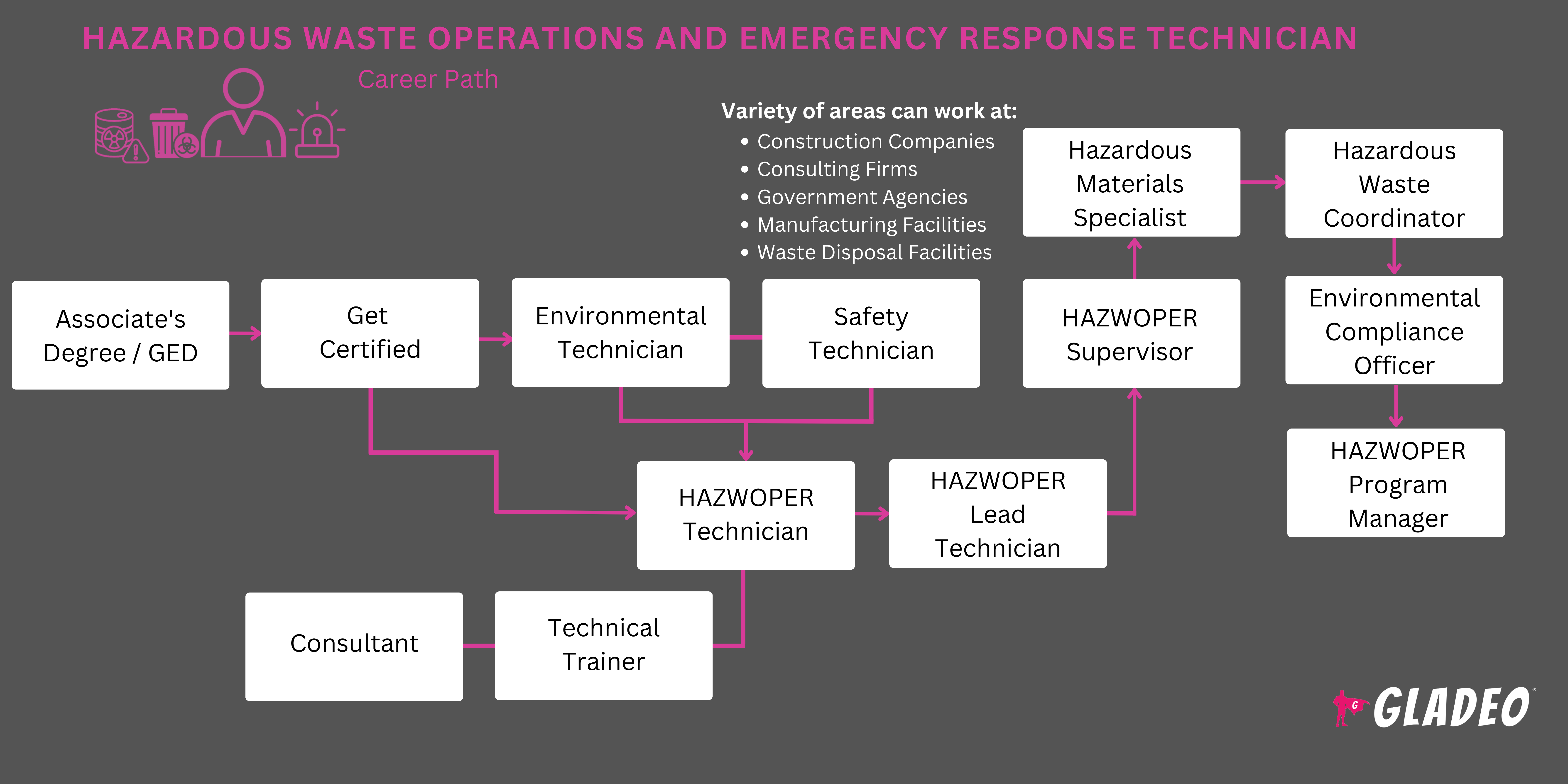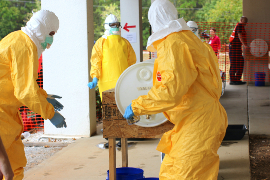聚光灯
危险材料技术员、危险废物技术员、危险材料专家、危险材料应对技术员、环境修复技术员、环境清理专家、化学品泄漏应对技术员
人类擅长制造危险物质!从有毒化学品和腐蚀剂到医疗废物、易燃材料和爆炸物,全世界每年产生约4 亿吨危险材料。这相当于一百万座帝国大厦的重量!
危险废物可能产生于化学品、石油、煤炭产品、杀虫剂、化肥、铁和钢的生产过程中。危险废物还来自废物处理和处置、放射性元素、铅、石棉、氡气、砷、汞--不胜枚举。
面对如此多的危险材料,我们需要知道如何安全处理它们的专家。这就是危险废物操作和应急响应技术人员(或 HAZWOPER)的用武之地!
这些经过专门培训的专业人员确保危险物质不会危害工人、社区、野生动物和环境。HAZWOPER 还被要求对事故和紧急情况做出反应,他们可以帮助清理废料现场、处理泄漏、控制或中和有毒物质!
- 安全管理和缓解危险材料事故
- 保护公众、野生动物和环境免受有害物质的危害
- 获得应急响应和危险废物管理方面的宝贵技能
工作日程
HAZWOPER 全职工作,因紧急情况或其他事故响应而加班的情况很常见。
典型职责
- 应对日常和紧急危险材料事件。评估危险情况
- 适当时,使用监测设备测量或测试材料造成的危害程度(如辐射程度
- 计划并执行安全管理和清理危险材料的程序
- 在应急响应或废物处理过程中,与团队合作防止接触/污染
- 施工前准备好隔离区
- 清理前根据需要中和有害物质
- 确定并穿戴适当的个人防护设备(如连体服、手套、面罩、呼吸器等)。
- 可能在密闭空间、高空或恶劣天气下工作
- 使用清洁剂、化学品和/或工具清除受影响表面的有害物质
- 操作机器或车辆,协助清洁、处理和运输
- 根据需要搅拌混凝土,以包裹将要处理的废物
- 对细菌可安全分解的物质采用生物修复方法
- 包装、装载、运输或储存废物。严格遵守危险废物处理方法和法律
- 标记并跟踪要清除的废物。保存材料转移地点的文件和记录
- 根据指示在垃圾填埋场或其他场所进行分类;将可回收利用的废物分离出来
额外责任
- 掌握最新的危险材料处理程序和法规
- 遵守有关安全、道德和法律要求的组织、州和联邦政策或法规
- 联邦机构的例子包括环境保护
局和职业安全与健康管理局
- 与团队领导和成员密切合作,确保整个工作和所有任务的安全和正确执行
软技能
- 积极倾听
- 以合规为导向
- 协调
- 批判性思维
- 注重细节
- 监测
- 耐心
- 规划和组织
- 解决问题的能力
- 具有安全意识的
- 强大的沟通能力
- 健全的判断力
- 团队合作
- 时间管理
技术技能
- 熟悉化学品,包括溶剂和清洁剂
- 操作升降机、叉车、起重机或卡车和山猫(如需要)
- 体力和耐力
- 安全和应急协议(如使用紧急淋浴和洗眼台)
- 安全使用手动和电动工具,如真空吸尘器、喷砂机、高压喷雾器等)。
- 使用适当的个人防护设备和相关装备
- 使用危险材料监测设备
- 急救/CPR
- 事故指挥系统
- 国家事件管理系统
- OSHA 锁定/挂牌
- 密闭空间进入和救援
- 资源保护和恢复法》知识
- 化工厂
- 建筑工地
- 应急响应服务提供商
- 政府和环境机构
- 危险废物处理、储存和处置设施
实验室 - 生产设施
- 采矿作业
- 溢油清理场
- 私人承包商
- 修复和废物管理服务
- 超级基金场地
几十年来,发生了无数起涉及有毒物质的环境灾难,影响了数百甚至数千人的健康和生命。在某些情况下,接触有毒物质的程度可能会非常严重,导致一个地区多年无法居住。
因此,有害物质清除工人是一项非常重要的工作,需要快速应对各种情况。当遇到大型紧急工作时,轮班时间可能会很长,有时工人在清理工作中会试图走捷径。然而,HAZWOPER 技术员必须抓紧时间,确保工作正确完成,这不仅是出于安全考虑,还因为违规行为可能导致高昂的罚款。
显然,危险废物是危险的,因此他们还必须严格遵守安全规则,以避免人身风险。他们还要迅速有效地中和并清洁所有受影响的表面,以免废物对其他工人、当地社区、附近的野生动物或整个环境造成影响。
危险品搬运工人年轻时可能喜欢户外活动或参加体育活动。他们可能还喜欢作为团队的一员为共同的目标而奋斗,比如在体育运动中。
- 危险品搬运工人必须年满 18 岁,持有高中毕业证书或普通教育证书
- 工人不需要大学学位,但必须完成基于 OSHA 标准的培训课程
- 雇主确定培训的适当小时数(通常至少 40 小时):
- 现场安全与健康人员
- 危害识别
- 个人防护设备
- 风险最小化工作实践
- 安全使用控制装置和设备
- 医疗监督
- 安全与健康计划内容
- 培训计划必须符合 OSHA 的 HAZWOPER 标准。许多课程可以在网上完成,但有些课程可能需要实际操作部分
- 需要针对呼吸器佩戴、核材料、OSHA 锁定/挂牌、密闭空间进入和救援以及其他特殊领域进行额外培训
- 经理和主管还必须完成额外的培训
- 相关工作经验(如建筑业)可帮助 HAZWOPER 更快地掌握知识
- 使用或运输某些废料(如石棉和铅等)必须获得州颁发的许可证或执照。这些许可证/执照通常要求通过考试并参加继续教育课程
- 工人可能需要学习如何操作升降机、叉车、起重机或卡车。通常会提供以下培训
- HAZWOPER 使用各种手动和电动工具,如真空吸尘器、喷砂机、高压喷雾器等。通常会提供培训
- 急救/CPR
- 某些职位可能需要具备事件指挥系统和国家事件管理系统方面的知识
- 可选的认证包括。
- 联邦汽车运输安全管理局- 危险材料认可证
- 危险材料管理研究所--注册危险材料从业人员
- 国际安全管理人员认证委员会- 注册危害控制经理
- HAZWOPER 不需要大学学位。培训通常由雇主或相关政府机构根据需要提供。不过,如果学生想获得证书或副学士学位,可以在社区学院或职业/贸易学校报名参加危险材料管理和废物处理技术课程。课程和计划应符合 OSHA 的要求。
- 那些希望获得更高级职位的人可以在以后获得危险品管理或环境科学的学士学位。
- 关注高中数学和化学课,志愿参加学生活动,学习团队合作和项目管理知识
- 参加车间课程,熟悉使用手动和电动工具,或在建筑行业找到一份兼职工作
- 志愿参与社区建设项目,如人类家园项目
- 参加体育锻炼计划,以增强本职工作所需的体力和耐力
- 了解各种危险品环境和职业选择。尝试决定您想在哪个领域工作
- 查看招聘信息,寻找您所在地区提供培训的机会
- 考虑参加危险材料清除工人学徒培训
- 如果需要,在职业学校或社区学院学习一些危险品相关课程或获得证书,以帮助提高您的资历
- 工人可能需要持有有效的驾驶执照,因此如果您没有驾驶执照,您可能需要学习并参加考试以获得驾驶执照。

- 雇主可能会提供所有必要的培训,但有些雇主希望工人具备先前的经验或专业证书
- 如果可能的话,在申请前积累实际工作经验。与建筑、清洁或使用工具和设备有关的工作在申请表上会很好看!
- 寻找与危险品处理或建筑相关的学徒机会
- 查看Indeed、Simply Hired 和Glassdoor 等招聘门户网站,以及Craigslist或您有兴趣为之工作的机构的职业页面
- 让你的关系网知道你在找工作。许多工作机会仍然是通过人脉和口碑发现的!
- 询问前任主管和同事是否愿意作为个人推荐人
- 您可能不需要简历就能申请,但请查看HAZWOPER 技术员简历模板,以获得一些想法
- 研究危险品搬运工的面试问题,为面试做准备
- 危险品处理工人的日常工作服并不华丽,但面试时要穿得专业一些!
- 如果您没有驾照,您可能需要一个驾照,因为许多工作都需要驾驶汽车
- 与上司讨论晋升途径。让他们知道你愿意采取晋升所需的步骤
- 积极寻找能帮助你发展事业的导师
- HAZWOPER 在获得足够的经验并完成 OSHA 主管培训后可获得晋升
- 在适当的时候完成高级认证
- 联邦汽车运输安全管理局的危险材料认可证
- 危险材料管理研究所的注册危险材料从业人员
- 如果您没有学士学位,请考虑获得学士或硕士学位
- 掌握数字工具和技术方面的高科技技能,如
地理信息系统或数据分析软件 - 要求学习如何操作任何可能帮助你进步的工具、设备或车辆
- 志愿参与复杂或高知名度的项目
- 尝试在各种环境下工作,如政府机构、私营企业或非营利组织,以拓宽你的经验。但也要寻求在高需求领域的专业化,如工业废物管理、应急响应或有毒材料处理等。
- 认真对待自己的工作,遵守规程,在安全方面树立榜样,并证明自己已准备好承担更多责任,从而建立信任
- 在团队中有效协作并展现领导力
- 某些角色需要州颁发的许可证或执照,因此请尽快获得许可证/执照
- 加入工会和其他组织,发展你的专业网络。参加讲习班或研讨会。为行业期刊撰写文章
网站
- 有毒物质和疾病登记局
- 美国工业卫生协会
- 能源部
- 交通部
- 环境保护局
- 环境保护局 - 废物管理
- 联邦汽车运输安全管理局
- 危险材料协会
- 危险废物清理信息 (CLU-IN)
- 危险材料管理研究所
- 国际安全管理人员认证委员会
- 国际固体废物协会
- 北美劳动者国际联盟
- 矿山安全与健康管理局
- 国家环境卫生科学研究所
- 国家安全委员会
- 核能研究所
- 核管制委员会
- 职业安全与健康管理局
- 修复行业协会
- 世界卫生组织
杂志和期刊
书籍
- 危险材料意识与操作》,罗伯-施奈普著
- 危险材料监测和探测设备,克里斯托弗-霍利著
- 管理危险材料:Maribeth S. Bradfield PE 著,《管理危险材料:权威文本》(Managing HazardousMaterials: A Definitive Text)。
作为一名危险废物处理人员,意味着工作时间长,需要遵守大量安全协议,并有可能接触到对健康有长期影响的有害废物。这是一份重要的工作,但未必适合所有人。
如果您想了解一些相关职业,美国劳工统计局建议您选择以下职业:
- 建筑工人
- 消防员
- 绝缘工人
- 水和废水处理厂及系统操作员
- 弹药处理专家
- 公路养护工人
- 回收和再生工人
- 垃圾和可回收材料收集员
- 化粪池维修工和下水管道清理工
您可能还会对环保职业感兴趣,例如
- 棕地重建专家
- 保护科学家
- 建设和建筑督察
- 环境合规督察
- 环境工程技术员
- 环境健康与安全(EHS)干事
- 环境安全技术员
- 环境科学家
- 消防检查员
- 地质技术员
- 危险废物技术员
- 健康和安全工程师
- 水文学家
- 工业卫生学家
- 材料科学家
- 微生物学家
- 采矿和地质工程师
- 职业健康与安全专家
- 公共卫生官员
- 安全经理
- 水/废水工程师
- 水资源专家
- 野生动物生物学家
新闻联播

特色工作

在线课程和工具







